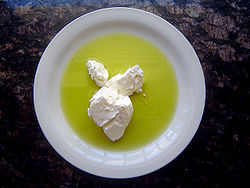Suzma

Strained yogurt with olive oil
|
|
| Alternative names | chak(k)a, Greek yogurt, labneh, suzma, yogurt cheese |
|---|---|
| Type | Yogurt |
| Place of origin | Middle East or Central Asia |
| Region or state | West, South, and Central Asia; Middle East, Southeastern Europe |
| Main ingredients | Yogurt |
| 457 kJ (109 kcal) per 100 g kcal | |
| |
|
Strained yogurt, Greek yogurt,yogurt cheese, or labneh (Arabic: لبنة labnah), is yogurt that has been strained to remove its whey, resulting in a thicker consistency than unstrained yogurt, while preserving yogurt's distinctive, sour taste. Like many types of yogurt, strained yogurt is often made from milk that has been enriched by boiling off some of its water content, or by adding extra butterfat and powdered milk. In Europe and North America, it is often made with low-fat or fat-free yogurt. In Scandinavia, particularly Iceland, a similar product, skyr is produced.
Strained yogurt is sometimes marketed in North America as "Greek yogurt" and in Britain as "Greek-style yoghurt", though strained yogurt is also widely eaten in Levantine, Eastern Mediterranean, Near Eastern, Central Asian and South Asian cuisines, wherein it is often used in cooking (as it is high enough in fat content to avoid curdling at higher temperatures). Such dishes may be cooked or raw, savory or sweet. Due to the straining process to remove excess whey, even non-fat varieties of strained yogurt are much thicker, richer, and creamier than yogurts that have not been strained.
In western Europe and the US, strained yogurt has increased in popularity compared to unstrained yogurt. Since the straining process removes some of the lactose, strained yogurt is lower in sugar than unstrained yogurt.
It was reported in 2012 that most of the growth in the $4.1 billion US yogurt industry came from the strained yogurt sub-segment, sometimes marketed as "Greek yogurt". In the US there is no legal definition of Greek yogurt, and yogurt thickened with thickening agents may also be sold as "Greek yogurt".
...
Wikipedia
